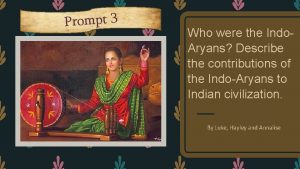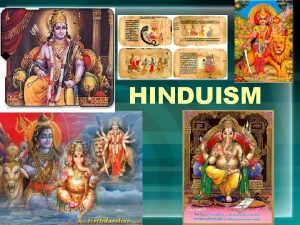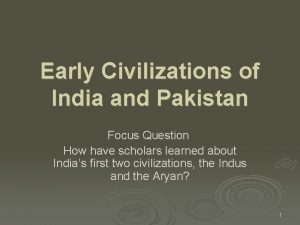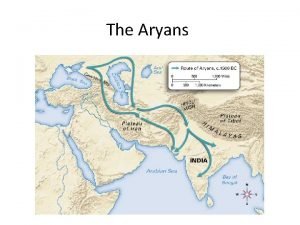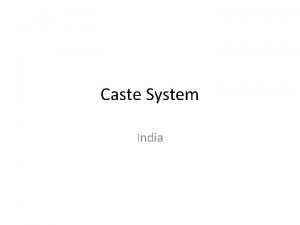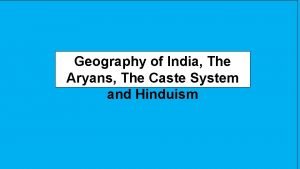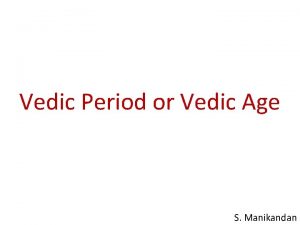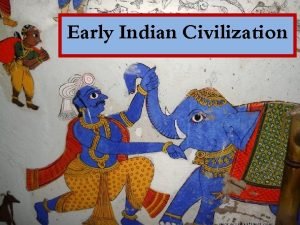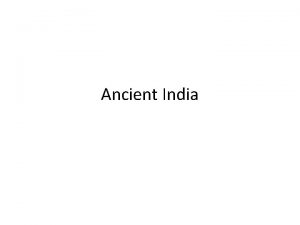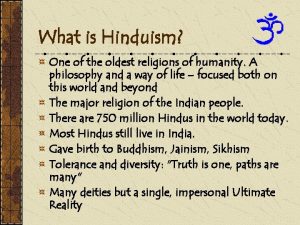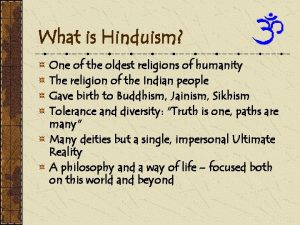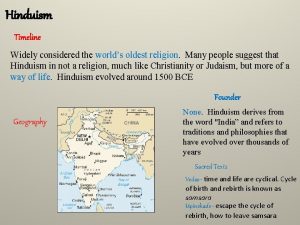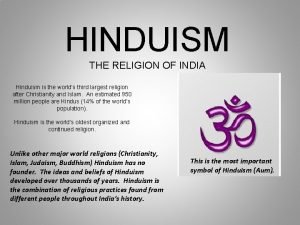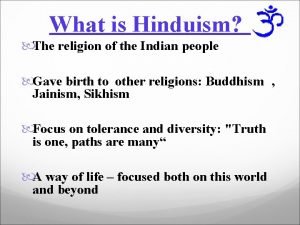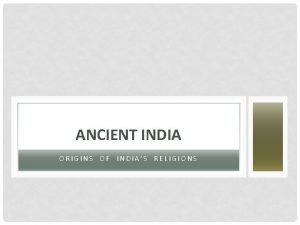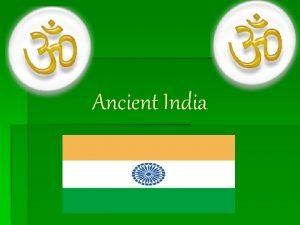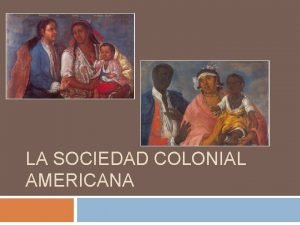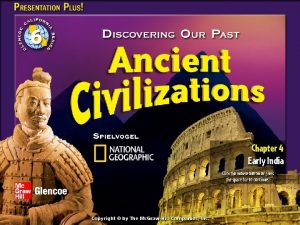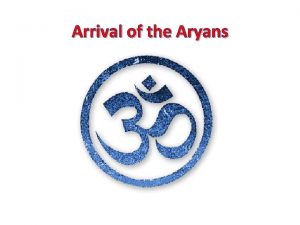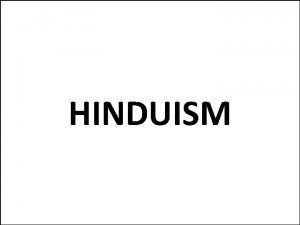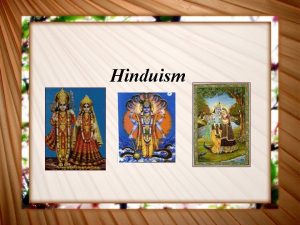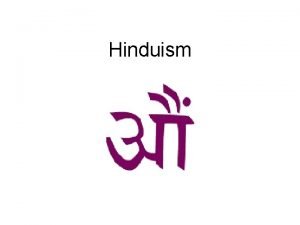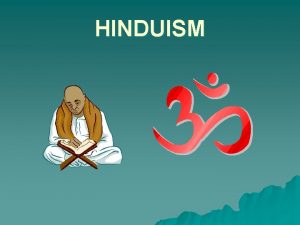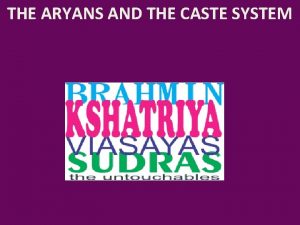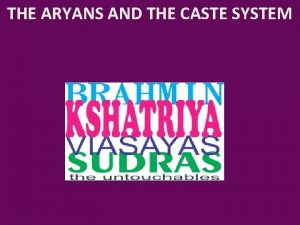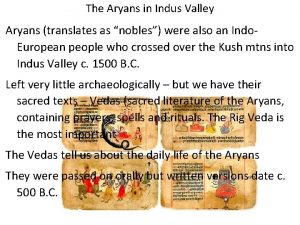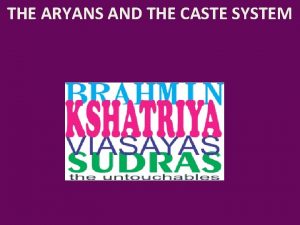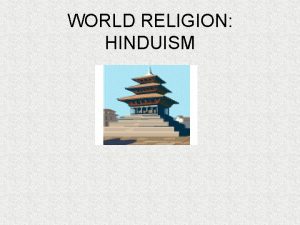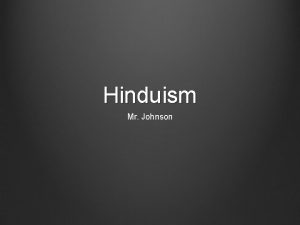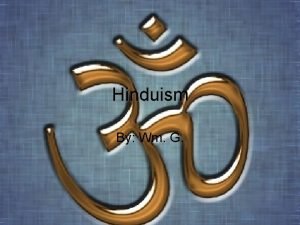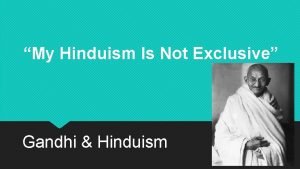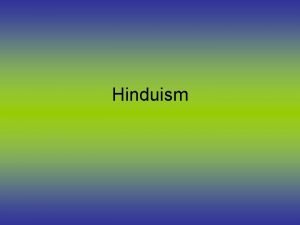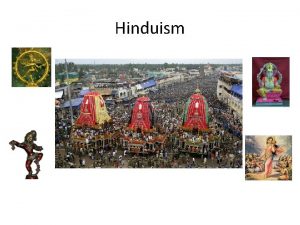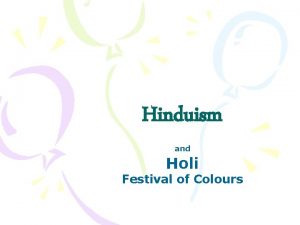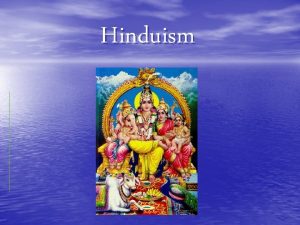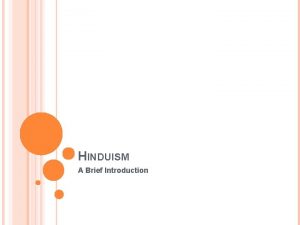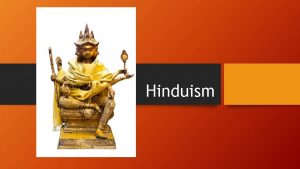Hinduism Indias 1 religion The Aryans were a
























- Slides: 24


Hinduism – India’s #1 religion The Aryans were a group of Indo-European people that moved from the dry grasslands of western Asia (the steppes), into what is now India starting about 1700 BCE and captured the land people of the Indus Valley. Archaeology tells almost nothing about the Aryans. But their sacred literature, the Vedas, tells a lot about them. The Aryans were divided into classes of people. Over time, they made many rules for how people in these classes, or castes, could interact with one another. People were born into their caste for life. These castes were initially determined by varna — literally, color. The Aryans were light skinned, and comprised the upper castes, while the native peoples found in India were darker skinned, and made up the lowest caste

Caste System The upper three classes consisted of Aryan people while the bottom two were the local native Indian people.

The Aryans were a group of Indo-European people that moved from the steppes into what is now India.

“Untouchables” Some “impure” people lived in a group outside this class system. (ie. They were out-castes. ) They were butchers, grave diggers, and trash collectors. Because they did work that was thought unclean, they were called “untouchables”.

The Caste System – social class system 1. The caste system is the traditional hereditary social class system that affected every aspect of their life – their job, their status, who they could marry, and even who they could talk to. 2. Hindus are born into their caste and could not get out until their death 3. There was no SOCIAL MOBILITY – could not move up in social class!

Basic Hindu Beliefs 1. The Gods a. Brahman – the Creator b. Vishnu – the Preserver c. Shiva – the Destroyer 2. Reincarnation – the soul never dies, it is reborn and goes through many lives until it can unite with Brahma

Hindu Beliefs continued 3. Karma – a person’s behavior in life determines their caste in the next life 4. Dharma – Your DUTIES in life to family and caste, do your job well!

Hindu Beliefs continued 5. Cremation – Burn body to release soul for next life

Sacred Objects • Cows – Hindus refuse to eat beef , they roam freely • Ganges River – Holy river believed to wash away evil • Today 85% of all Indian people are Hindu

From Hinduism Comes Buddhism Around 528 BCE another new religion, Buddhism, arose in India. It was started by Siddhartha Gautama, a prince. The founder, Siddhartha Gautama, has many legends and stories that have surrounded his life. While we can't be certain which of these stories and legends are true, we do know that the basic historical outlines of his life are accurate.

Beginnings of Buddhism l He was the chief's son of a tribal group, so he was born a Kshatriya (Warrior class) around 566 BC. l At the age of 29, he left his family in order to lead a simple life. l A few years later he returned with a number of followers; followers that devoted their lives to "The Middle Way“, a lifestyle that is midway between a completely simple lifestyle and one that is full of materialistic goods. l Siddhartha searched for a way that would allow him to escape the suffering of human life. He spent many years searching for this answer. He was looking for enlightenment, or wisdom. l Finally, he sat down and meditated under a tree. After 49 days, he had his answer. He was now called the Buddha, which means “enlightened one”. The Buddha began to teach others how to attain enlightenment.

Following the path led to Nirvana

Buddhist Beliefs The Four Noble Truths l Suffering is universal – everyone suffers l Cause of suffering is DESIRE l If you end your desires – suffering will end (necessary to reach NIRVANA- a release from selfishness and pain. ) l Follow the EIGHTFOLD PATH –

How to become enlightened Buddhists were to follow a plan of behavior called the Eightfold Path — right views, right resolve, right speech, right conduct, right livelihood, right effort, right mindfulness, and right concentration. This would lead to nirvana, or a release from selfishness and pain.

Other Buddhist Beliefs 1. Believed in KARMA and DHARMA and REINCARNATION – 2. REJECTED THE CASTE SYSTEM – felt it was not fair, unjust!! “Not by birth does one become an outcast, not by birth does one become a Brahmin. By DEEDS one becomes an outcast, by DEEDS one becomes a Brahmin” – Buddha

Spread of Buddhism l Buddhism spread from India to China and other parts of the world along the SILK ROAD – l The sharing of religion is an excellent example of cultural diffusion.

India first Empires Maurya & Gupta

The Maurya Empire In 321 BCE, the founder and eventual King of the Maurya Empire, Chandragupta Maurya used his army to defeat powerful kings in eastern and northern India. By 305 BCE, he began to challenge for Alexander the Great’s western territories in India, and by 300 BCE, for the first time, northeastern and northwestern India were joined under the rule of one person. Chandragupta was a harsh ruler. He charged a heavy tax on farmers — one-half of the crop they grew each year. He used this wealth to build a huge army. He controlled his government by carefully choosing officials and watching them closely

The Maurya Empire l l l In 269 BCE, Chandragupta’s grandson, Asoka, took the throne. He brought the Mauryan Empire to its greatest height. At first he was a warlike king but then he decided to accept the teachings of the Buddha. Asoka promised to rule in a fair and just way. He issued laws that urged his subjects to avoid violence. He urged religious toleration. This is acceptance of people’s rights to differing religious beliefs. He made great roads so that people could travel easily. Asoka is also known as “the lawgiver” because he carved the laws into stone pillars which were placed in the center of towns.

Some of the Pillars of Asoka Sanskrit Language

The Gupta Empire Soon after Asoka died, however, his empire collapsed. Around 320 AD, Chandra Gupta I came to power in the north. He was not related to the first emperor Chandragupta Maurya of the Maurya Empire , but he took the title of king and began to conquer other areas in the name of the Gupta Empire.

The Gupta Golden Age Added western coast to empire l religion l science l Flourishing of arts l

500 healing plants identified 1000 diseases classified Printed medicinal guides Plastic Surgery Gupta Achievements Kalidasa Literature Medicine Inoculations Gupta India C-sections performed Decimal System Mathematics Concept of Zero PI = 3. 1416 Solar Calendar Astronomy The earth is round
 Who were the aryans
Who were the aryans What is indias main religion
What is indias main religion Aryans of india
Aryans of india Aryans definition
Aryans definition Label each caste system
Label each caste system Caste system geography
Caste system geography Vedic period
Vedic period Indo-ayran
Indo-ayran Aryans defintion
Aryans defintion What is the oldest religion
What is the oldest religion Oldest religion
Oldest religion Caste system graphic organizer
Caste system graphic organizer Is hinduism a religion
Is hinduism a religion What is hinduism
What is hinduism Largest ethnic religion
Largest ethnic religion The maurya and gupta empires
The maurya and gupta empires Indias religions
Indias religions Flota de indias ruta
Flota de indias ruta Indias religions
Indias religions Indian caste system
Indian caste system Indias first empire
Indias first empire Virreinatos capitanias y audiencias
Virreinatos capitanias y audiencias Indias first civilization
Indias first civilization Western religion vs eastern religion
Western religion vs eastern religion Was/were going to (future in the past)
Was/were going to (future in the past)
